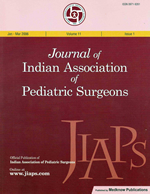
|
Journal of Indian Association of Pediatric Surgeons
Medknow Publications on behalf of the Indian Association of Pediatric Surgeons
ISSN: 0971-9261 EISSN: 1998-3891
Vol. 11, Num. 1, 2006, pp. 10-11
|
Journal of Indian Association of Pediatric Surgeons, Vol. 11, No. 1, January-March, 2006, pp. 10-11
Editorial
Pediatric laparoscopy - past, present and future
Srimurthy KR
President, IAPS, 2005-2006
Correspondence Address:President, IAPS, 2005-2006
Code Number: ip06002
"Nothing endures but change"
- Heraclitus
Thanks to innovative technology and equally adept pediatric surgeons laparoscopy in pediatric surgical practice has become a reality.
Initially there was reluctance on the part of pediatric surgeons to
undertake laparoscopic procedures in spite of the same being well established
in adults. Perhaps, the reason being that many of our pediatric surgical
colleagues who were well established in the art of open surgery were
afraid of the long learning curve of the new technology and reluctant
to apply to new born babies and children. Of course, lack of proper instruments,
bulky equipment, insufficient experience of pediatric laparoscopic anaesthesiologists
also added to the hesitancy. However one must commend the perseverance
of a select group of pioneering pediatric surgeons to pursue the new
technology to its ultimate goal.
Initially, Laparoscopy was used mainly for diagnostic purposes like
UDT, intersex, repositioning of VP shunt tubes. Given the window
to the abdomen it fired the imagination of the pioneering surgeons to
rapidly upgrade themselves in specialized laparoscopic skills. Innovative
approaches were created to overcome the problems of creation of space,
eye to hand co-ordination, trocar placement, depth perception tissue
handling, energy devices, knotting and suturing. Each procedure completed
gave the pediatric surgeon the impetus to explore newer laparoscopic
options. Having successfully mastered the technique of diagnostic
laparoscopy
excisional procedures like appendix, gall bladder, spleen were next
on the list.
Simultaneously, there was distinct improvement in instrumentation,
digital videoscopy, harmonic scalpel enabling surgeons to explore
newer possibilities like thoracosocopy, repair of diaphragmatic
hernia, vascular
ring etc. Once the pediatric surgeons reached the level of intra
corporeal suturing reparative procedures were handled with ease
and comfort.
Sky became the limit. Stapling instruments facilitated faster intra
corporeal procedures. Repair of Tracheo-Oesaphageal fistula, Hydronephrosis
Duodenal Obstruction were undertaken with excellent results.
All these developments came at the appropriate time to take pediatric
laparoscopic surgery to the next higher level. It directly translated
into minimizing scars, minimal pain, shorter stay in the hospital.
It is imperative that the present day pediatric surgeon be fully
acquainted with this new approach or the market forces will take
the enlightened
parents away to an MIS (Minimal Invasive Surgery) centre with
expertise.
"We are made wise not by recollection of our past but for our responsibility
for our future"
- George Bernard Shaw
Technologies are revolutionizing the approach to all fields of science
especially in medicine, they have improved delivery systems of
drugs, created new molecules and sophisticated instruments to reach
previously
inaccessible portions of the body safely. As surgeons it is our
duty to foresee the future using available technology so that we
become innovators of procedures rather than mere copy cats.
"Past cannot be changed, the future is still in your power"
- Hugh White
Telemedicine the new mantra along with faster pace of communication
and image transfer technology have opened the doors to the
spread of medical
knowledge. Using digital communications and fibre optic lines
one can transfer images to an centre of excellence for an appropriate
feed back on the best management practices without shifting the
patient or the
surgeon.
Virtual Reality is a computer generated technology, create
simulated life like environment. 3-D images seen on the screen
actually
bleed when cut, deform on pressure. VR opens up new vistas
in education,
training
and planning surgical procedure.
Advances in 3-D imaging have added a new dimension to the
safety of Laparoscopic surgery. It literally recreates
human vision
by throwing images on two
different monitors facilitating depth perception. Visual
comfort so
achieved translates into faster and accurate hand movements
especially involving
intricate procedures Head up display as worn by high altitude
pilots enhances visual facility decreases fatigue and improves
quality
of surgical procedures
Robotics and computer assisted systems have added a new
dimension in the field of laparoscopic surgery. It facilitates
complex
surgical procedures to be performed by a surgeon sitting
in a chair adjacent
to an operative
suite either in the same hospital or across the globe.
Stress levels are reduced to the minimum. Accuracy is
achieved without
sacrifice
of safety. Although in the present context it is exhorbitantly
expensive it overcomes the problem of learning curve,
as one expert can sit
in
a centre of excellence and conduct surgeries across the
world. It enables wartime injuries to be handled expertly,
where
there is lack
of specialists
in the battlefield and future applications for patients
in international space stations. Robotics is here to
stay and
will replace endoscopic
and open surgery shortly.
"Innovation replaces tradition. The present or perhaps the future replaces
the past. Nothing matters so much as what will come next and what will
come next can only arrive if what is here now gets overturned"
- Schumpeter - Grove
Copyright 2006 - Journal of Indian Association of Pediatric Surgeons
| 